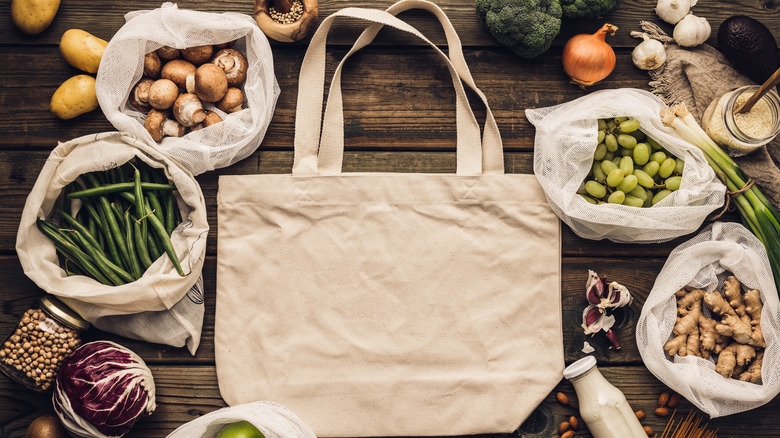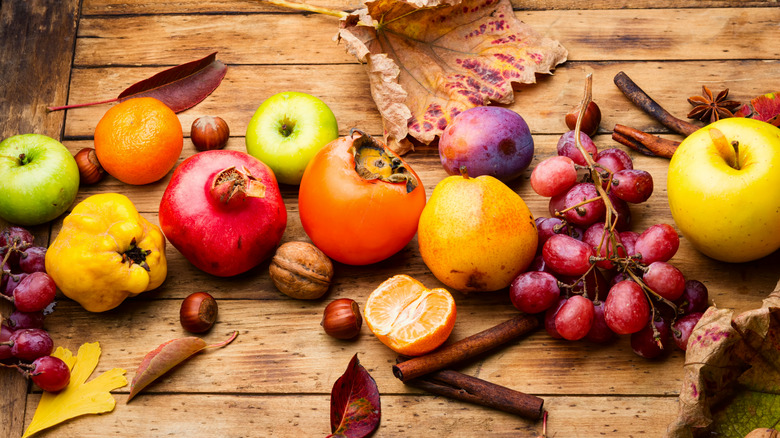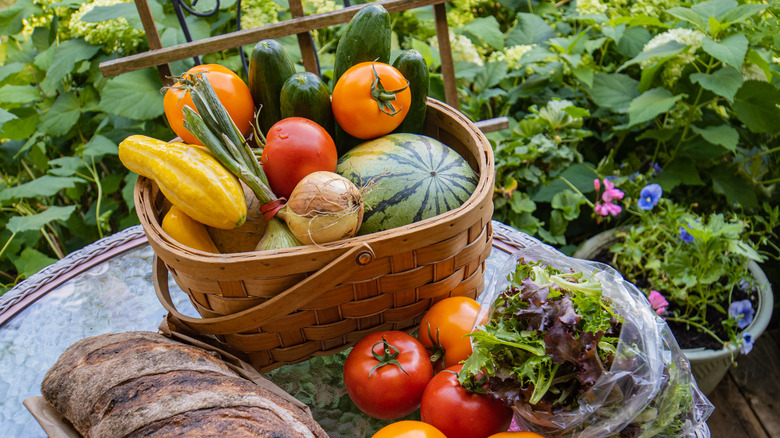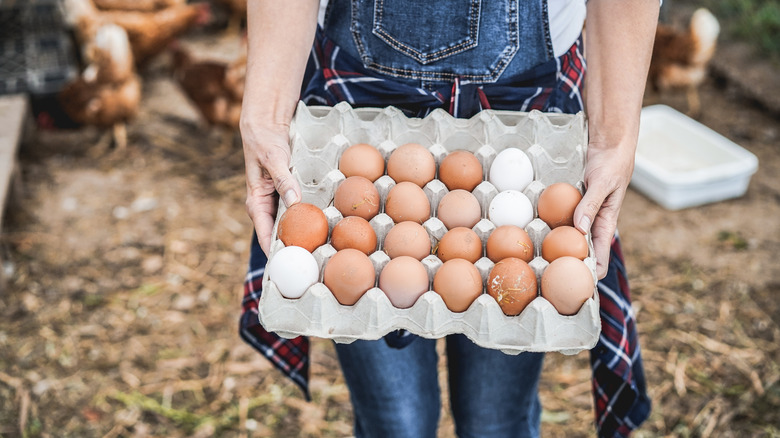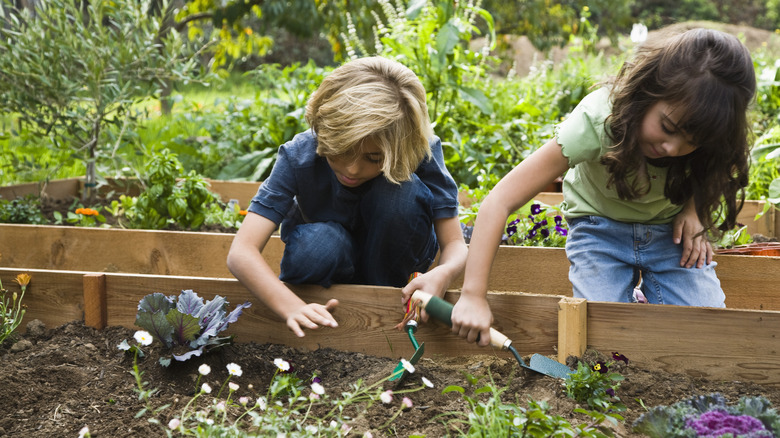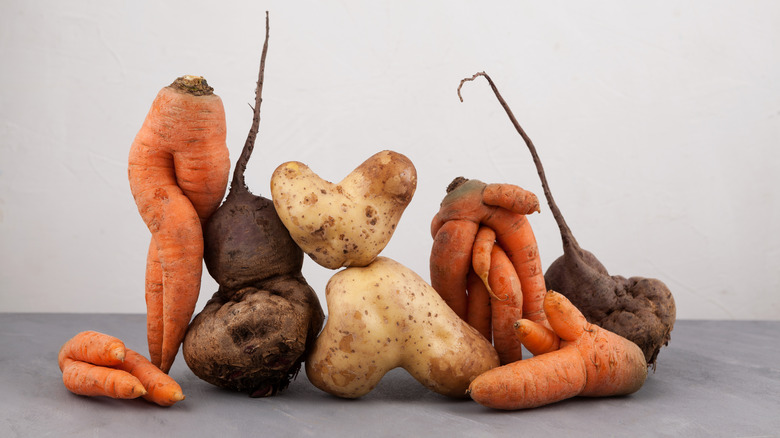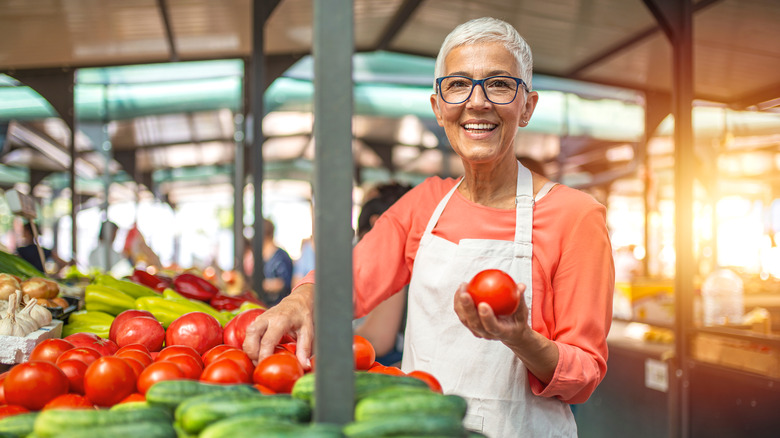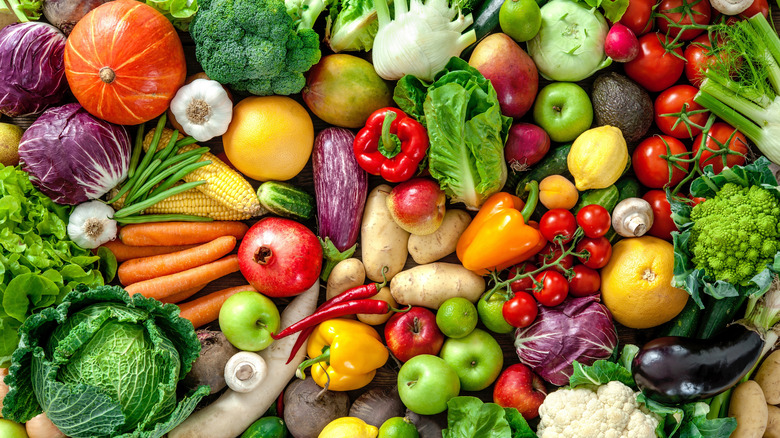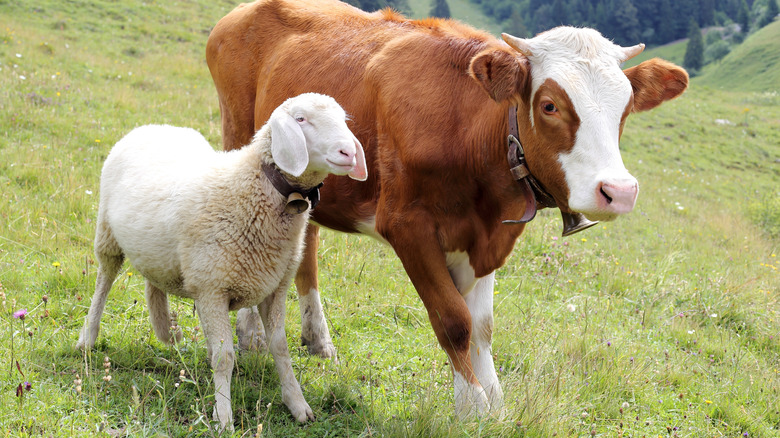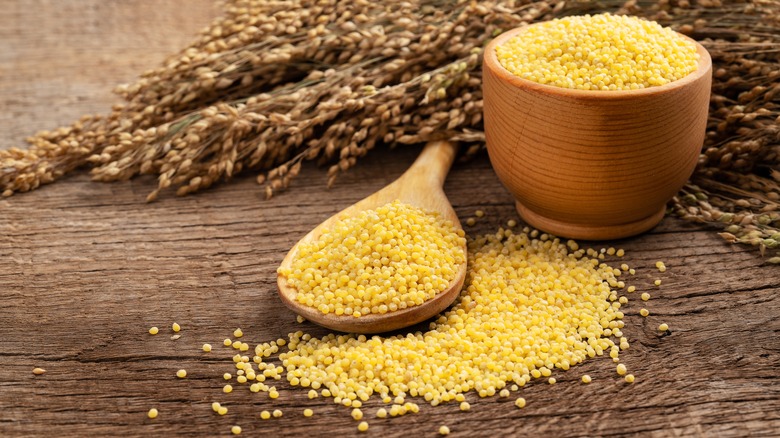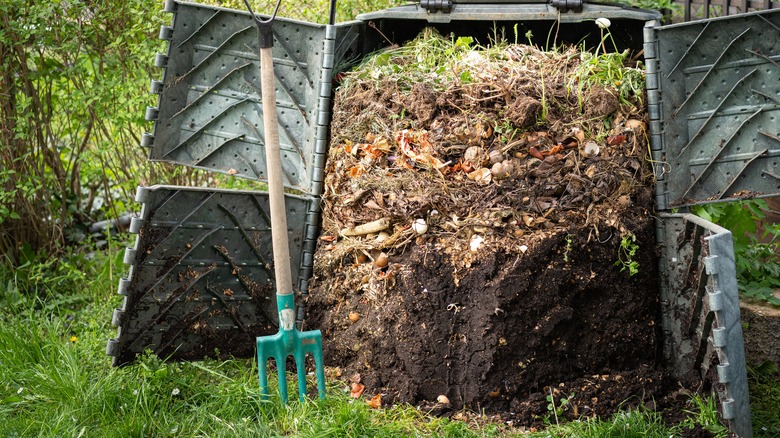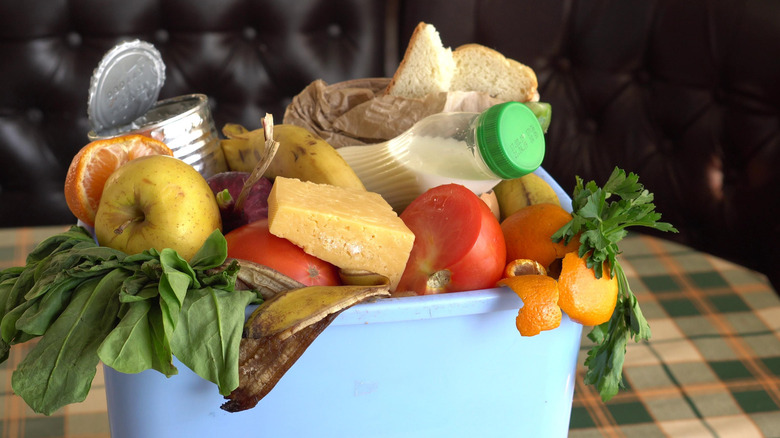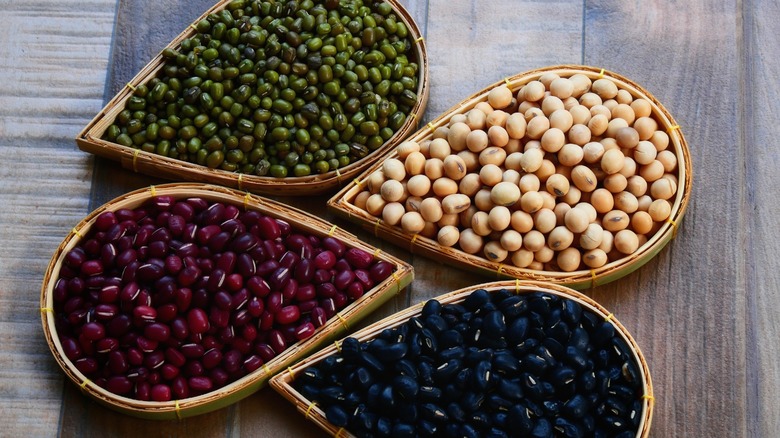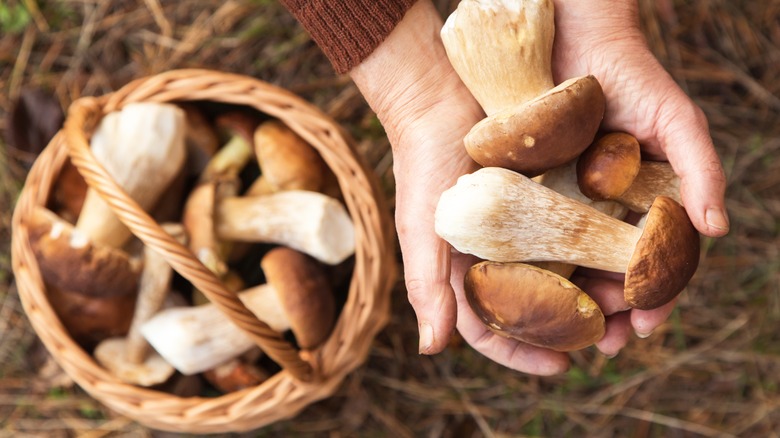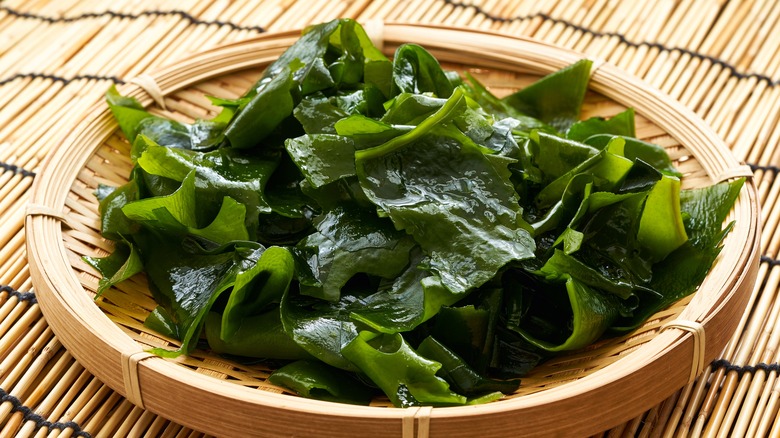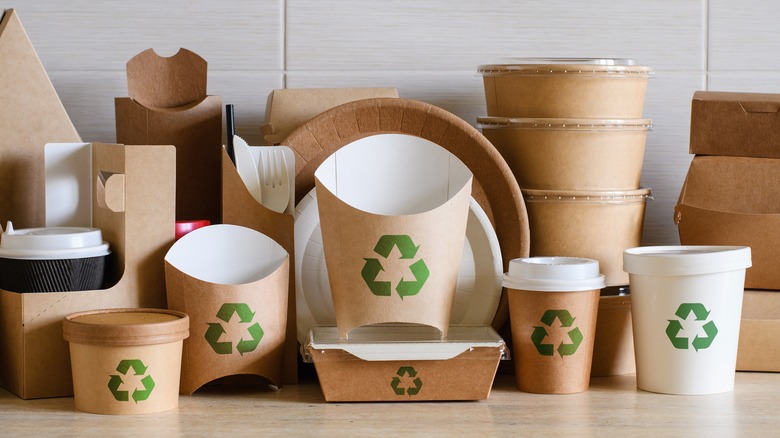What You Need To Know About Climate-Conscious Eating
The awareness of our daily impact on our environment is becoming increasingly important. Our climate is changing and it's imperative that we begin to discover ways to manage the ramifications we are already experiencing while also mitigating further damages. The problem may seem bigger than one individual, but if each of us does our best to contribute solutions, change is possible.
While there are myriad ways to reduce our carbon footprint or the degree to which our daily behaviors influence CO2 emissions and greenhouse gas emissions, perhaps the most important — and most achievable — is through climate-conscious eating. What we put into our bodies is critical to the fight against climate change. From how foods are grown and manufactured to how they are distributed and disposed of, every step of the food production life cycle can positively or negatively impact the environment.
Knowing how your consumption habits can be more sustainable is the first step in being part of the solution. Climate-conscious eating not only protects the environment for future generations but also helps you to consume more nutritious and delicious foods in the here and now. And fortunately, there are so many possible avenues for climate-conscious eating habits to emerge.
Eat seasonally
Contrary to what we observe in the grocery store, having unlimited access to all fruits and vegetables year-round is unnatural. Science has evolved the capacity to produce tomatoes or strawberries in the winter, but not without using enormous quantities of nonrenewable resources in the form of fossil fuels. Additionally, growing foods out of season negatively impacts the soil's ability to regenerate nutrients that produce more healthful and delicious food (via WebMD), making eating seasonally critical to climate-conscious eating.
Eating seasonally also encourages the consumption of a more diverse variety of products, something we have all known is critical for long-term health and wellness. While not everyone will have access to or the means at their disposal to consume seasonally fresh produce, it is easier than you might believe. Resources exist, like this Seasonal Food Guide, which, when populated with your state and time of year, will help you to discover what foods are typically available in your area at any given time. You can also encourage your local grocer to begin carrying locally and seasonally grown produce, creating an opportunity for you and your grocer to work harmoniously to make more climate-conscious choices.
Join a CSA
CSA, or Community Supported Agriculture, is a subscription-based farm-sharing model in which a consumer pays for a portion of the produce or meat grown on that farm in a given season. This symbiotic relationship provides farms with working capital to keep their farms going while providing consumers with healthy, fresh, and sustainably grown food.
There are several distinct models of a CSA. Seasonal CSAs are generally open from spring through fall, but winter CSA's, which rely on growing foods hydroponically or aquaponically in greenhouses, do exist as well. Multiple farm CSAs allow several farms to combine forces, providing more variety while minimizing marketing costs for the individual farms. Entire meal CSA's package foods from all food groups to create full meal options for their subscribers. Set dollar CSA's require payment at the beginning of the season, and then keep track of what the subscriber purchases until they have a zero balance. Non-food CSAs may sell anything from wildflowers to crafts. You can find a CSA near you by visiting Local Harvest and entering your location into their database.
Join a Food Co-op
A food co-op, or cooperative, is a community-based operation that allows producers, workers, and consumers to work in a democratic way to provide food to members and non-members alike. Some co-ops have a physical location, while others operate strictly online. The model is less important than the mission. Co-ops buy locally, meaning they actively reduce the carbon footprint of the food bought through them. Co-ops diversify, meaning they can be flexible in an ever-changing world of varying dynamics and needs. Co-ops maintain rigorous product standards, often focusing on only foods that are sustainably grown, organic, and non-GMO. Employees of a co-op often have better benefits and working conditions and are invested in the mission. Co-ops frequently give back to the community by either directly donating or arranging to give excess unused food to a local food pantry or homeless shelter.
What this means for you is access to sustainably grown foods at more affordable prices. Many co-ops also offer educational opportunities (like cooking or gardening classes), bulk specials or members-only coupons and discounts, and access to a network of like-minded individuals committed to climate-conscious lifestyles. To locate a food co-op near you, visit the National Co-Op Grocers (NCG) website and search their database.
Build a community garden or plant your own veggies
Gardening is a popular pastime for many individuals. Not only is it an opportunity to spend time outdoors, but it is good exercise and may promote better mental health (via WebMD). Growing food, however, comes with additional benefits, ranging from saving money and using sustainable growth practices to consuming a greater variety of fruits and vegetables. However, if you live within the confines of a large metropolitan area where home gardens are few and far between, planting a garden may present logistical challenges. Here is where community gardens come in.
Many big cities are cleverly repurposing buildings, parking lots, and more to establish plots of land for members of the community to come and grow food. The potential positive impacts of planting these community gardens are enormous. Community gardens can fill a nutritional gap in a food desert, curtail food insecurity by making fresh food more affordable, educate children and adults alike about where food comes from and how it grows, promote community cooperation, and reduce individual carbon footprint. In a society with an increasing gap in economic resources between the haves and have-nots, a community garden can become the focal point of societal change that is also climate-conscious.
Buy seconds, or ugly produce
Seconds — ugly or imperfect produce — don't look aesthetically appealing. It may have bruises or blemishes, or be otherwise odd looking. This produce may get rejected by grocers, who stock their shelves with uniform-looking fruits and vegetables. But the reality is, there is nothing wrong with these vegetal misfits. They are just as nutritious and can be far less expensive than their more photogenic siblings. The biggest issue with discarding or ignoring ugly produce is food waste. For those concerned with our carbon footprints wanting to eat more climate-consciously, we should be seeking out these foods.
You can source seconds in many different ways. The best ways to find them are from local farmer's markets or directly from farmers via a food co-op or a CSA. You can also ask your local grocer what they typically do with imperfect produce that has passed its prime or arrives at the store this way. Ask them to start a program where they are willing to sell these items in bulk at a discount. It makes good business sense for the grocer and provides consumers with a sustainable produce option. And finally, many ugly food delivery services exist where you can sign up for a subscription, similar to a CSA, and get a box of imperfect food delivered right to your doorstep.
Eat local
Often when we focus on climate-conscious eating, we turn to the topic of buying organically produced food. While this isn't a bad practice from the perspective of reducing potentially harmful pesticides, herbicides, and fertilizers, all of this is moot if it takes a ton of fossil fuels to get this organic produce to your local grocery store from farms located thousands of miles away (via Healthline). Many of these foods are also highly processed and packaged in polluting plastic containers, which add to pollution rather than combating it. Additionally, many foods transported long distances get harvested before they are ripe, meaning they are less nutritious and flavorful than fresh food sold at your local farmers market, grocer, or CSA.
You can combat these cons by buying your organic food from local farms and distributors. Perhaps the most valuable aspect of eating locally-grown food is the ability to support local farmers and businesses. Keeping resources within the community benefits everyone in the local economy. A community that develops long-standing relationships with local farmers, with the families of both producers and consumers growing up alongside each other, creates an interdependent system within which everyone is committed to one another. The sense of responsibility to others that this fosters cannot be replicated. Farmers markets are a great place to start making local connections, and you can also choose specific farms to partner with for all your produce, meat, and dairy needs.
Eat less meat
Humans have evolved to be omnivores, meaning we thrive on consuming diverse plant and animal-based foods. However, increased meat consumption has led to a perfect storm that has contributed to the decimation of communities and the environment. Factory farming devastates the environment in several ways. Greenhouse gas emissions associated with meat production are high. Not only do cows emit high volumes of methane, but adding fertilizer and nitrogen to soil has led to high nitrous oxide emissions. All of this gets compounded by the fact that deforestation, fueled by the conversion of land for agriculture, accounts for 45% of greenhouse gas emissions. Land doesn't get cleared solely to support growing livestock — it makes way for crops needed for feed. The process of deforestation also leads to the disproportionate displacement of local populations who unfairly bear the brunt of climate change.
Eating less meat can create significant change, even if you're only foregoing meat in your meals once a week. The bonus to consuming less meat — doing so is good for your health. According to the Mayo Clinic, those consuming less meat tend to weigh less and have lower risks of death from heart attacks, strokes, and diabetes. Eating less meat is not just climate-conscious — it is health-conscious.
Buy meat that has been humanely raised
While there has been some debate about the environmental advantage of raising animals sustainably, including suggestions that when animals live longer, they produce more methane from burping, there are many reasons to switch to humanely raised meat. First, humanely raised animals have more space to roam about and eat more natural diets, necessitating fewer antibiotics.
Second, factory farming denudes the soil, eroding nutrient concentration and causing run-off, which can contaminate the water supply. Additionally, this run-off has led to dead zones, or areas where excessive nitrogen and phosphorous have created an overproduction of algae. When the algae die, they contaminate the water as they decompose, resulting in the blockage of sunlight necessary for underwater grasses — which aquatic animals feed off of — to grow. This results in the inability of natural bodies of water to sustain the life that is critical to their ecosystems.
And finally, buying humanely sourced meat from a local farm can reduce the carbon footprint caused by transporting factory-farmed meat across long distances. As a bonus, it strengthens the local economy by supporting small and family farms. That's a win-win situation for everyone involved.
Buy organic grains
While we all know we should eat a more plant-based diet, some plants are better for the environment than others, like organically produced whole grains, which are far more sustainable to grow than fruits, vegetables, seeds, and nuts (via The Beet). Grains require less water to grow and have a longer shelf-life than fruits and vegetables, which decreases food waste and reduces their carbon footprint. However, even among grains, there are better and worse options for sustainability.
At the bottom of the spectrum is rice, which requires a lot of land and water to produce and emits methane, a greenhouse gas, when rice paddies get flooded. Whole wheat also uses tons of water in its production, often requiring substantial fertilizers and pesticides to grow. Rye is one of the best grains because of its resistance to extremes in weather and its particularly long root system capable of permeating even the driest and nutrient-deficient soil. It also emits a chemical that stunts the growth of weeds.
Oats are another great option thanks to their water-absorbing roots and their use as a crop to rotate with other crops, which helps to prevent soil erosion. The most sustainable whole grain is sorghum or millet, which acts like a natural greenhouse gas vacuum, removing carbon dioxide and replenishing the soil. It also requires very little water to grow and is extremely high in nutrients, making it one of the best hopes for climate-conscious eating.
Compost
Composting is one of the best ways to contribute to a climate-conscious lifestyle. Every year, approximately 50% of the trash ending up in landfills is material that could be composted (via Institute For Local Self-Reliance). Landfills contribute to greenhouse gas production and pollute local soil and water sources. Learning how to compost at home or finding a local facility where you can take your compostable materials is simple. When done safely, composting has a myriad of benefits. It creates high-quality soil to use when fertilizing crops, enhances microbial diversity, reduces greenhouse emissions by trapping methane instead of releasing it into the atmosphere, can prevent soil erosion, and can aid in the reforestation of devastated environments.
Contrary to popular belief, many items you may not have thought were compostable are compostable. These include small pieces of uncoated cardboard, coffee grinds, eggshells, fireplace ashes from natural wood, hair and fur, hay and straw, houseplants, leaves, shredded paper and newspaper, nutshells, sawdust, teabags, and wood chips are all compostable. If you don't have your own space or need for a compost heap, FindAComposter.com can help you find a place to bring your food waste.
Reduce food waste
According to the USDA, approximately ⅓ of the available food supply in the U.S. gets wasted. 81% of this food waste goes into landfills or combustion facilities that pollute the environment with greenhouse gas emissions and contaminate local soil and water supplies (via EPA). Not only does this represent an enormous economic waste, but it also involves the waste of resources used in the production, processing, transportation, preparation, and storage of food, each of which contributes to increasing our carbon footprint.
Simple ways to avoid wasting food include: Meal planning, taking an inventory of foods in your refrigerator and pantry before going to the grocery store, keeping a running grocery list, and not overbuying because something is on sale if you don't think you will eat it all, purchasing from bulk bins to reduce packaging waste and buying imperfect (or upcycled) products. Additionally, store foods properly to minimize food spoilage and consider labeling food items to ensure they get consumed in order of what may spoil first. And finally, don't cook more than you need unless you intend to use your leftovers.
Support climate-conscious food businesses
Being climate-conscious isn't just a good individual decision but a good business one, too. According to research conducted by Deloitte, 38% of respondents are actively engaged in climate-conscious activities (via the Wall Street Journal). Additionally, 23% of consumers report basing purchasing decisions upon a business sharing their environmental concerns, particularly among younger generations. And 65% of those responding expect companies to take meaningful steps in making their businesses more sustainable, particularly in the food retail, manufacturing, processing, and hospitality sectors.
As a consumer, you can influence businesses to transition to more sustainable business practices by deciding where to spend your money. As they say, money talks, and mindfully opting to buy from a local farmer's market over a big box store, staying at a hotel that promotes eco-friendly practices, or dining at a restaurant that sources their food from local farms lowers your carbon footprint while simultaneously keeping those businesses viable. It also enables a climate-conscious business organization to offer its products and services at lower costs, which may help encourage participants who believe that being climate-conscious is not within their financial means.
Look for climate-conscious food labels
According to Nature Food, the food industry is responsible for one-third of all greenhouse gas emissions, with beef production representing the highest percentage (via CNN). Restaurants can contribute to aiding consumers to make more climate-conscious menu decisions by implementing labeling that indicates items with lower or higher climate impact. A study conducted by JAMA researched such a labeling method. The simple-to-read red and green light labels were somewhat effective in influencing purchasing decisions. When red labels indicating food items with high climate impact were present, 23% of consumers opted for more sustainable choices. Alternately, green labels indicating food items with low climate impact only influenced 10% of consumers to opt for the more sustainable menu item.
Similar research was conducted by the World Resources Institute in 2022, testing ten different menu labeling ideas. Many of these were quite effective in influencing diners to opt for more climate-conscious options, including "swapping just one meat dish for a plant-based one saves greenhouse gas emissions that are equivalent to the energy used to charge your phone for two years," which doubled the percentage of those deciding upon a more sustainable option (via CNN). This type of labeling is relatively new. Most restaurants do not offer them — yet. However, they may be more prevalent online, so don't forget to check.
Eat more beans, pulses, and legumes
According to the University of Sheffield, the world population will reach 9.7 billion by 2050. That is a logistical nightmare where sustainable food production is concerned. We already know that meat production is problematic for the environment in several ways, but how can we obtain enough protein to feed almost 10 billion humans? The answer is beans, pulses, and legumes. Beans produce 90% fewer greenhouse gas emissions than beef (via The Monday Campaigns). They can also improve soil quality by absorbing nitrogen from the air and returning it to the ground. Beans require 20% less land than cattle per pound of protein to produce and 43 times less water. Residual nitrogen left behind from bean production can help naturally fertilize other crops while increasing the biodiversity in the soil. And finally, beans are incredibly nutritious and affordable, making them a no-brainer as a climate-conscious option. The biggest hurdle to increasing bean consumption lies in educating people about how to eat them.
Consume more mushrooms
Fungi are a powerful component of a sustainable ecosystem (via the United Nations Decade on Ecosystem Restoration). Their vast networks permeate virtually every part of the globe, performing incredible feats necessary to preserve the environment. First, fungi are integral in converting nutrients, like nitrogen and phosphorus, needed for other plants to thrive. They do this through the decomposition of plant and animal waste. Fungi also play a role in carbon sequestration by working with plants to absorb carbon from the atmosphere and return it to the soil. Where pollution is concerned, fungi can decompose toxins like plastics, pharmaceuticals, personal care products, and oil. There are even species that can aid in pest control, as well as reforestation. And several companies have begun manufacturing products like packaging, clothes, shoes, and skincare products from the biodegradable Mycelium, or root systems, of fungi.
From a culinary perspective, mushrooms are abundant and require zero agricultural waste to grow. They consume waste in production, making them virtually carbon neutral. Many mushrooms have higher protein than meat, are loaded with nutrients and minerals, and may have anti-viral properties. Saying mushrooms and fungi are miraculous life forms is an understatement. We must protect the biodiversity of fungi by mitigating deforestation, soil degradation, and salinization.
Eat more seaweed
Seaweed may not appear to be an integral part of a climate-conscious food system, but it is. Not only are some species of seaweed higher in protein than meat, but many also contain more calcium and iron than dairy or meat (via Eco & Beyond). Seaweed is also rich in iodine, fiber, and omega-3 fatty acids. And because of its umami-rich flavor, it can be a delicious part of any meal.
But more importantly, it is sustainable. Seaweed grows without any fertilizer, freshwater, land erosion, or deforestation. It is a fast-growing food, with a rate of approximately 12 feet in three months, making it a cost-effective food source. Seaweed also absorbs toxins from the water as it grows, enabling other marine life to thrive. And finally, it has a negative carbon footprint, absorbing 20% more carbon dioxide from the atmosphere than it produces. Considering that the ocean represents 70% of the planet, the potential for seaweed to become an integral sustainable food option is immense.
Stop using disposable plates, napkins, and utensils
Disposable cutlery, which encompasses plastic plates, utensils, straws, to-go containers, and napkins made of plastic, aluminum, or steel, is a menace to the environment. Anyone desiring to be more climate-conscious in their eating habits must re-evaluate their consumption of take-out food and the packaging involved. Disposable cutlery pollutes waterways, making them toxic for animals and humans to consume. It can also endanger wildlife that may ingest them. Its production involves high greenhouse gas emissions. And they take up to 450 years to biodegrade, which has allowed our landfills and oceans to slowly become inundated with them.
There are solutions, however, in which both consumers and restaurants can engage. Bringing your cutlery or reusing cutlery is a start. Compostable cutlery is also becoming more mainstream, as is edible cutlery. When choosing where to dine, demand that they shift to more sustainable cutlery options, and make sure that you are disposing of these accordingly. If you throw compostable or edible cutlery in the trash, this defeats the purpose of their existence. And if you do get plastic cutlery, remember to recycle it.
Stop buying bottled water
Bottled water is convenient and perhaps necessary in countries where the drinking water may be contaminated, but when possible, avoiding bottled water is a must. Producing bottled water involves an immense carbon footprint (via Harvard University). The U.S. alone requires 17 million barrels of oil to manufacture enough bottled water to meet demand. And 86% of plastic water bottles end up in landfills. Since plastic can take up to 450 years to decompose, this is a catastrophic amount of plastic polluting our planet. Bottled water costs 3,000% more than tap to produce, making it an economic waste. As a general rule, tap water is regulated in the U.S., making it no less safe to drink than bottled water. Where there are concerns over drinking water safety, we recommend installing a reverse osmosis system or investing in a water filtration unit. Bringing a reusable water bottle with you is the best practice for your health and the health of the climate.
